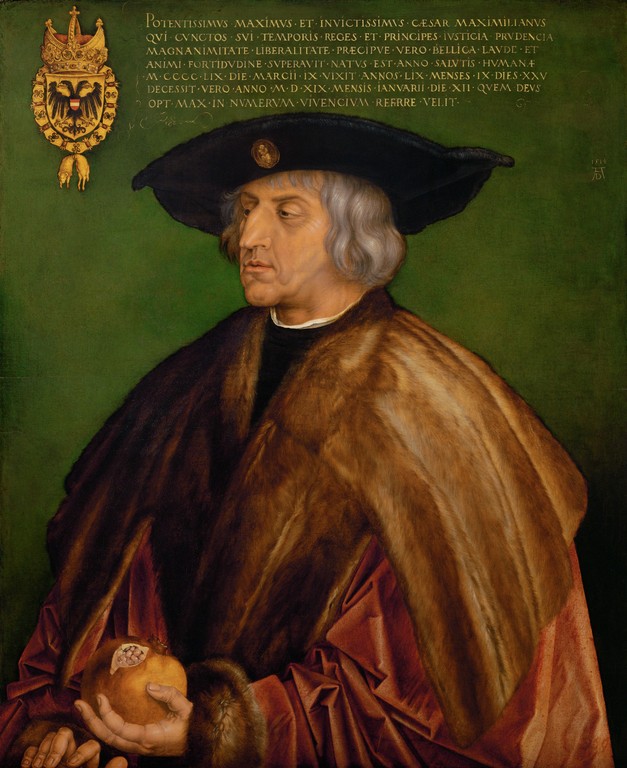Medieval History

Does anybody fancy buying a piece of medieval English embroidery, I certainly would if I didn't have a wife and children to support? Well an Italian dealer, Piselli Balzano, have a panel of late medieval embroidery for sale on their website. They claim the piece was made for the marriage of the Holy Roman Emperor Maximillian I to Mary of Burgundy in 1477. The double-headed eagles on it are of course the badge of the Holy Roman Empire, so its plausible, although this is a motif that exists on other medieval English textiles. I quite like the idea that English embroidery was good enough for the Hapsburg family. The dealers website doesn't say any more about the provenance, or even whether it was part of a vestment or a domestic hanging. The thing that caught my eye was that apart from the eagles, other design elements on the panel bear a striking similarity to the Careby cope fragment featured earlier in the week, particularly the seraphs on wheels and the central image of the Assumption.

Maximillian I

Mary of Burgundy
BTW have a look on the rest of the dealers website they have some rather lovely medieval and renaissance silks and voided velvets.

- The Lyng Table Carpet
One of the most tragic losses of the Reformation was undoubtedly the destruction of fine ecclesiastical textiles. Many thousands of vestments were confiscated and destroyed during the reign of Edward VI and many others were taken...
- More Medieval Vestment Recycling!
I hope you aren't getting too tired of my minor obsession with late medieval English textiles. Here is another example of the post-medieval recycling of medieval vestments. Buckland in Gloucestershire has a lovely frontal made from various pieces...
- Advent Blue
This is a glorious little piece of late medieval English embroidery in the V and A. It formed part of an altar frontal, of unknown provenance, given by Henry Smyth and his wife and their son Thomas Smythe and his wife. It dates from the final quarter...
- Butterfield's Interpretation Of Medieval Textiles
William Butterfield (1814-1900) was one of England's most accomplished and prolific Gothic Revivalists. Between 1881 and 1883 he built St Mary Magdalene's, Enfield in Middlesex. Every aspect of the building and its decoration is by Butterfield,...
- Invention Of The Holy Cross
Norbury, Derbyshire, originally uploaded by Vitrearum.This figure of St Helen holding the True Cross is an appropriate image for today as we celebrate the feast of the Holy Cross, or to give it its western title Exaltatio Sanctae Crucis, the 'Raising...
Medieval History
Medieval English embroidery good enough for the Holy Roman Emperor
Does anybody fancy buying a piece of medieval English embroidery, I certainly would if I didn't have a wife and children to support? Well an Italian dealer, Piselli Balzano, have a panel of late medieval embroidery for sale on their website. They claim the piece was made for the marriage of the Holy Roman Emperor Maximillian I to Mary of Burgundy in 1477. The double-headed eagles on it are of course the badge of the Holy Roman Empire, so its plausible, although this is a motif that exists on other medieval English textiles. I quite like the idea that English embroidery was good enough for the Hapsburg family. The dealers website doesn't say any more about the provenance, or even whether it was part of a vestment or a domestic hanging. The thing that caught my eye was that apart from the eagles, other design elements on the panel bear a striking similarity to the Careby cope fragment featured earlier in the week, particularly the seraphs on wheels and the central image of the Assumption.

Maximillian I

Mary of Burgundy
BTW have a look on the rest of the dealers website they have some rather lovely medieval and renaissance silks and voided velvets.
- The Lyng Table Carpet
One of the most tragic losses of the Reformation was undoubtedly the destruction of fine ecclesiastical textiles. Many thousands of vestments were confiscated and destroyed during the reign of Edward VI and many others were taken...
- More Medieval Vestment Recycling!
I hope you aren't getting too tired of my minor obsession with late medieval English textiles. Here is another example of the post-medieval recycling of medieval vestments. Buckland in Gloucestershire has a lovely frontal made from various pieces...
- Advent Blue
This is a glorious little piece of late medieval English embroidery in the V and A. It formed part of an altar frontal, of unknown provenance, given by Henry Smyth and his wife and their son Thomas Smythe and his wife. It dates from the final quarter...
- Butterfield's Interpretation Of Medieval Textiles
William Butterfield (1814-1900) was one of England's most accomplished and prolific Gothic Revivalists. Between 1881 and 1883 he built St Mary Magdalene's, Enfield in Middlesex. Every aspect of the building and its decoration is by Butterfield,...
- Invention Of The Holy Cross
Norbury, Derbyshire, originally uploaded by Vitrearum.This figure of St Helen holding the True Cross is an appropriate image for today as we celebrate the feast of the Holy Cross, or to give it its western title Exaltatio Sanctae Crucis, the 'Raising...
